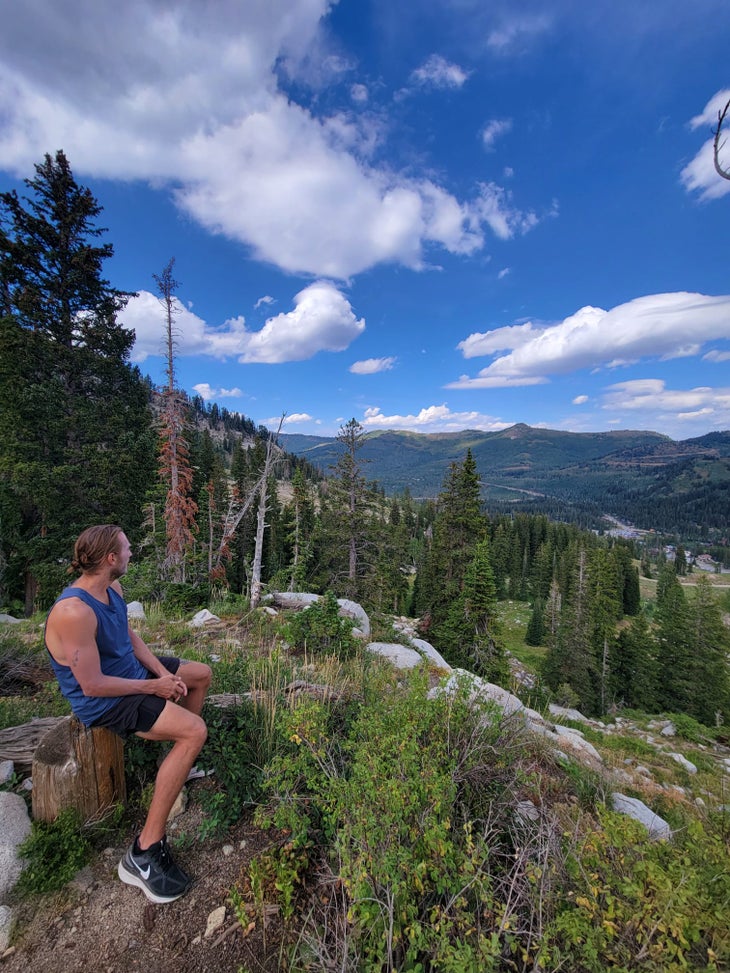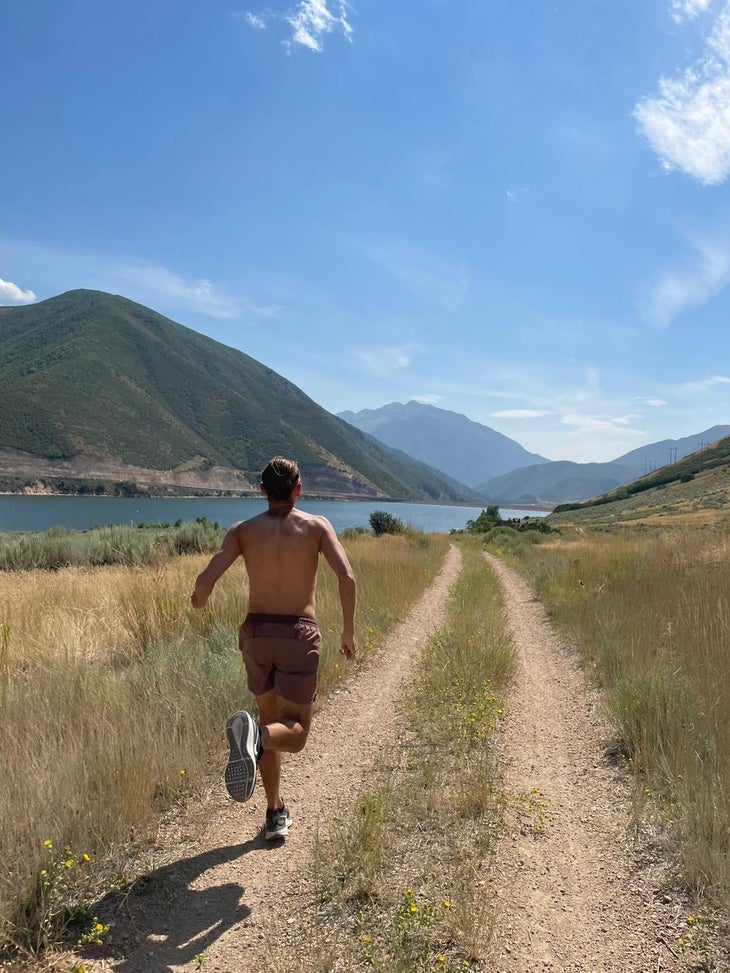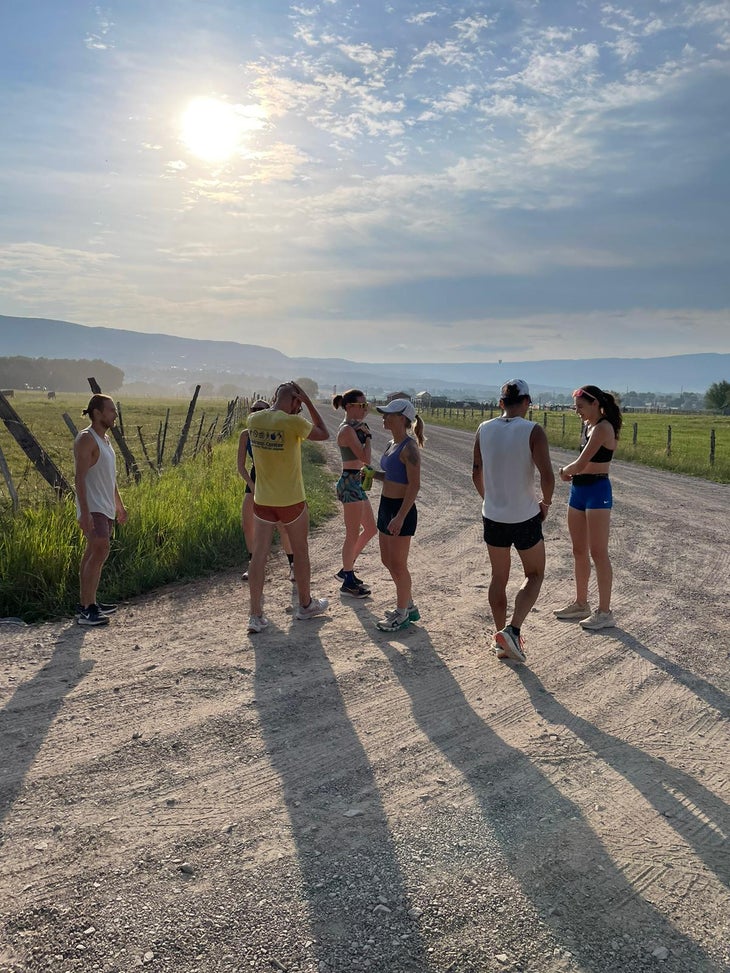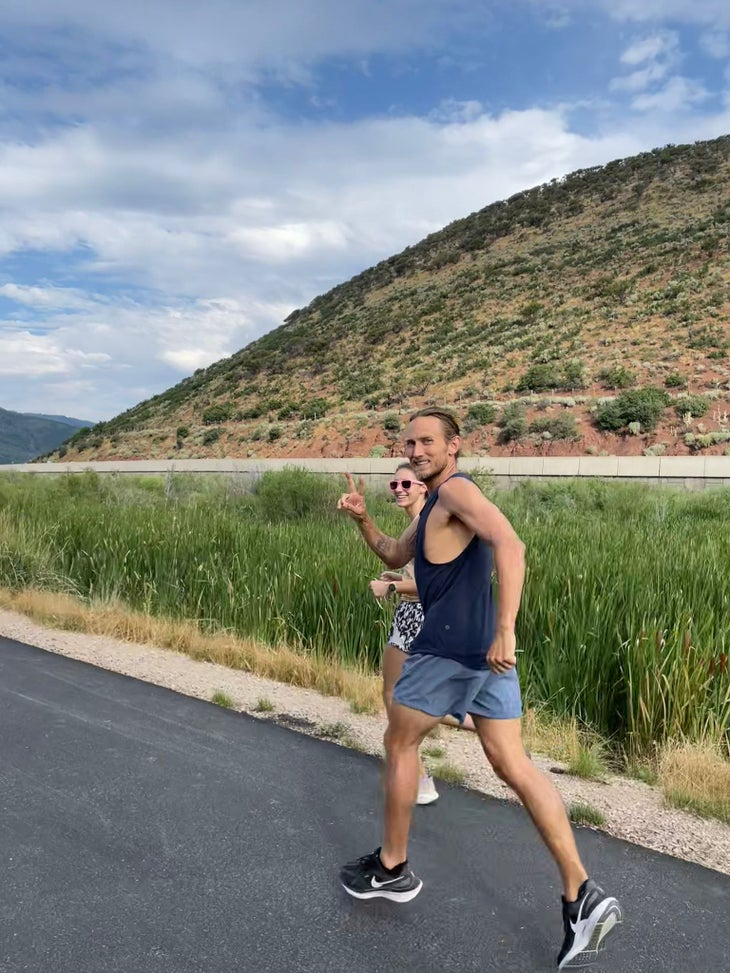No Data, No Apps—Meet the Sub-Elites Just Running by Feel

(Photo: Courtesy of Steve Mennitt)
On a dry, hot day last August, a group of runners from New York City perched on the hoods of their cars to refuel after a long run on the rocky, red road of Jeremy Ranch, just outside of Park City, Utah. Collegiate athletes prepping for cross-country season galloped by in packs, along with mountain bikers on elaborate rides festooned with gadgets. Though none appeared that day, pros are often spotted there too: At 6,400 feet above sea level, it’s a favored training ground for runners like Conner Mantz, Grant Fisher, and Keira d’Amato.
The group from New York clenched their phones, straining to see their screens in the morning glare as they entered their slogs on Strava. Over 2,000 miles away from home, there was no shortage of novel “Strava titles” available to city folk like them to capture Jeremy Ranch—by turns humbling, exhilarating, and majestic—for their followers.
In the distance, a slight figure, dressed in a black singlet and shorts, emerged from a shallow valley. In no time, he breezed by the group and shouted that he was adding on. How much, he had no idea, in the same way he had no idea how far he’d run. He knew only that he’d started with the group, then left them in the dust, and nearly two hours later, was still going while they munched on bagels in the sun.
After 15 or 20 minutes, the runner, whose name is Steve Mennitt, circled back, emptied a bottle of water down his throat, and described his route with landmarks: a cattle gate, a dead end, a long and punishing hill. It was up to James Chu, a coach who had brought Mennitt and the others to Park City for a week of altitude training, to calculate how far and fast he’d gone: roughly 20 miles at a pace of 6 flat.

Mennitt rarely runs with a watch, let alone one with GPS, and he isn’t on Strava or any other social media app. If he were, untold numbers of strangers to Mennitt would know that he, now 36, is one of the top runners in New York City’s hyper-competitive club racing scene. In this social media alternative universe, Mennitt might even be a runfluencer.
Instead, Mennitt is bucking the trend to commit every mile to the public record, something many of us might just flirt with from time to time: Earlier this year, 2:26 marathoner David Gleisner wrote about going watch-free for a month, and rediscovering the childlike joy running can provide.
For Mennitt, shedding the wrist computer is more than an experiment. After years of training with an early-generation Garmin–and getting injured a lot—Mennitt now runs year-round like people have for millennia—just one foot in front of the other, for however long and however fast feels right. “I really feel connected again,” he says. “I just listen to my body.”

Kudos at What Cost?
Solidly into the latest—fourth? fifth?–running boom, Strava can seem as ubiquitous as $300 racing shoes. In 2023, the company reported having 120 million registered users—six times more than a decade ago. And yet, Strava ranks in the bottom third of fitness apps by popularity. Google Fit has 375 million users and Apple Fitness has 275 million; even something called Sweatcoin has more users than Strava. Nevertheless, it’s rare to meet a competitive endurance athlete who isn’t on it. Those who’ve decided to opt out cite myriad reasons, but there are some common themes—chiefly, mental and physical well-being.
Kir Faraud, 37, started using Strava when she moved from Brooklyn to New Orleans and didn’t know anyone in her new city. “I felt isolated, so it was a way of encouraging myself and keeping up with friends and just knowing like, okay, my friends are running 10 miles today, so I might as well do it and get a few kudos or whatever,” she says.
She soon realized that she was comparing herself to those friends, almost entirely northerners who didn’t train in a swamp, and started feeling like she wasn’t performing at the standard she wanted. So she deleted her account.
Two Olympic Trials marathons and countless local wins later, Faraud is known throughout New Orleans as the Running Lady. She doesn’t recall when she got off Strava, but attributes her decision largely to getting back in touch with herself. “I don’t really think knowing too much about what other people are doing works for me,” she says.
For Ben Corson, a former D1 mid-distance specialist with an 800-meter track time of 1:53, running is a personal endeavor. “It’s you versus the clock,” he says, “versus the trail, the course, the distance.” Now 30, Corson has avoided social media since he deleted Facebook two weeks after joining the platform his freshman year of high school. “It was just difficult for me to manage a whole sort of virtual self while I was managing my analog self,” he says.
It was just difficult for me to manage a whole sort of virtual self while I was managing my analog self.
Corson sees the same problem with Strava. He knows when he’s slacking in workouts, he says, and no amount of validation or scrutiny from anyone else can match “the internal calculus or the pressure that I put on myself. In fact, it’s going to make it worse.”
Zander White, a Philadelphia-based distance runner who spends all day in front of a screen as a UX designer, is more blunt: “I think if people aren’t physically there for the pain, I don’t really care if they congratulate me or not,” he says.
These Luddites of the roads might be seen as embodying a growing cultural appetite for analog hobbies, particularly since the COVID-19 pandemic when everything from work meetings to birthday parties was flattened into one seemingly endless Zoom call.
Pottery has become so popular that some studios have an 18-month waitlist; woodworking collectives have sprouted up from San Diego to Queens. Meanwhile, American roots music is booming, and between 2016 and 2023 vinyl records sales leapt from 13 million to nearly 50 million per year–trends that reflect increased frustration with digital life. If Pics or it didn’t happen defined the 2010s, many people today seem to be living by a new mantra: If there are pics, were you really–fully–there?

Lost in the Feeling
Mennitt began running in fourth grade and was soon one of the fastest kids in his hometown of Edison, New Jersey. After racing track and cross country from middle school through college, he spent his 20s more devoted to late-night DJ sets than to morning workouts on the oval. He kept running to stay fit, though, and found that it wasn’t dissimilar to dancing. “It’s like when you’re getting lost in a really good song,” he says. “You’re just not even there. You’re just totally lost in that feeling.” He joined Brooklyn Track Club in 2022 to make friends and give structure to his training. In May 2024, he ran 1:10 at the NYRR Brooklyn Half, good for 40th overall out of more than 28,000 finishers.
Still, even Mennitt is not immune to the dopamine hit of virtual approval. “I do want the kudos,” he admits, “but I also don’t want that to be my main motivation to get out and run every day.” Otherwise, he worries his ego will get the best of him. “I’m pretty obsessive,” he says, adding that he does, in fact, crave all the data that’s available now–and the public recognition that comes with it. But if he has it, he says, “I just drive myself insane.”

After Mennitt left Park City last summer, he spent a week in Boulder, Colorado, before heading back to Brooklyn. Chu had gotten him a bib for the 2024 New York City Marathon—it would be his debut at the distance—and they both decided sub-2:30 was an achievable goal. Mennitt did most of his workouts with a group of guys aiming for the same and relied on them to keep their paces true, though by that point his own internal GPS was nearly as precise as their Garmins.
Marathon Sunday was pristine: bright, crisp, virtually no wind. The pro women cruised past the mile-9 marker and onto Bedford Avenue in Brooklyn. The pro men, who started later, weren’t far behind. Following them, a thin smattering of sub-elites climbed the gradual incline of Lafayette Avenue, many glancing at their watches every few strides.
Mennitt, shoulders loose, stride long, was there with them. As he charged up the hill at a steady 5:40 per mile pace, he smiled and waved to the crowd, looking as present and relaxed as he had that summer out at Jeremy Ranch. He finished in 2:30:04.
Nearly a year later, Mennitt is more committed to not running with a watch or sharing his runs than ever, and he certainly doesn’t let those few seconds over his goal in New York bother him. He reached a flow state, as he puts it, and for him, that matters more than a thousand kudos. “I’d rather just do things that make me happy,” he says, “and not because I want the world to see them.”